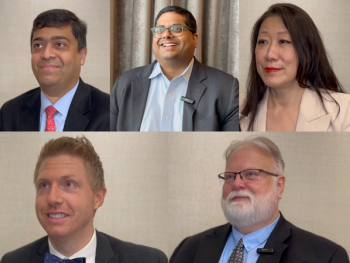
Screen More Former Smokers for Lung Cancer, Study Suggests
Data from the Mayo Clinic suggest that smokers who have quit longer than 15 years may need to be screened for lung cancer, yet they fall outside the window recommended by the United States Preventive Services Task Force.
Data from the Mayo Clinic suggest that smokers who have quit longer than 15 years may need to be screened for lung cancer, yet they fall outside the window recommended by the United States Preventive Services Task Force (USPSTF).
The study, presented Tuesday at the American Thoracic Society 2018 International Conference in San Diego, California, comes as USPSTF is updating its recommendation on screening with low-dose computed tomography, and major professional societies have tweaked their
In 2013, USPSTF
Ping Yang, MD, PhD, offered the presentation on behalf her colleagues from the Mayo Clinic. The researchers studied 8031 lung cancer patients age 55-80 years with at least a 30 pack-year history; if they had quit, it could be any time within the past 30 years. The study evaluated the lung cancer patients in 2 groups: a hospital-based cohort of 7168 patients, and a community-based cohort of 863 patients. Researchers adjusted for gender, race, age, cigarette smoking history, tumor stage, and treatment modalities to assess risk of overall death.1
The Mayo Clinic team found that the hospital patients who were long-term quitters were at a similar risk of death when compared with patients who meet the USPSTF screening criteria (hazard ratio [HR]=1.02, 95% confidence interval [CI], 0.94-1.10, P = 0.72). In the community cohort, long-term quitters were at the same risk of death as those meeting USPSTF criteria (HR=0.97, 95% CI, 0.75-1.26, P = 0.82).
In an interview with The American Journal of Managed Care®, Yang said the cutoff of not having smoked for 15 years is difficult for some patients, especially those who quit when they were young and have additional risk factors, such as obesity. “We need better biomarkers,” she said, that could be added to determine if longer-term quitters should be included in annual screening.
“Ultimately, we want to see a reduction in mortality,” Yang said. “That is the message.”
Income and follow up. Once patients are screened, do they follow through if the test shows they might have cancer? A study from Winston-Salem, North Carolina, finds a strong relationship between household income and a person’s likelihood to go through with a recommendation for a biopsy. The 268 patients in this study received a baseline scan between September 2014 and March 2016; adherence was defined as completing follow-up imaging or biopsy within 30 days of the expected date, as determined by the Lung Imaging and Reporting and Data System (Lung-RADS). Analyses were done based on household income, age, smoking pack-years, gender, and Lung-RADS category, with ZIP code serving as a proxy for estimated household income.
Average pack-years were 48.9, and most patients were still smoking (168, or 62.7%). The average household income was $60,656, with 177 (66%) making less than $60,000; only 11 patients (4%) made more than $100,000. Of the study group, 200 patients, nearly three-quarters (74.6%) did not adhere to imaging or biopsy orders within 30 days of the expected date. Males were less compliant than females (79.3% nonadherence vs 70% nonadherence). Age was not a factor in lack of adherence, but income was: those with household incomes above $80,000 had adherence rates of 33.3%, and those with household incomes of less than $50,000 had adherence rates of 17.9%. Overall, those with incomes above $60,000 had adherence rates higher than those with incomes below $60,000 (31.87% vs 22.03%, P =0.02).
Qualitative studies in communication. A pair of studies looked at aspects of communication between doctor and patient in making the decision to get lung cancer screening. “What Is Shared Decision Making?” involved 27 interviews with lung cancer screening coordinators, pulmonologists, primary care physicians (PCPs), and radiologists; clinicians and especially the PCPs expressed the importance of explaining risks and benefits of the screening, but to inform the patient this is their decision.3 PCPs were more likely to be in tune with patient values than other members of the team, including lung cancer screening coordinators. A companion study, “I Just Wanna Know,” focused on the patient perspective of the decision-making process, with evaluation taking place after a decision-making visit but before the scan itself.4 Those who opted for screening typically reported “just wanting to know” if they had lung cancer, or that they were willing to rely on the recommendation of their physician. Patients could not always recall specific information but felt they could get more if they wanted it.
References
- Luo L, Midthun DE, Wang Y, et al. Lung cancer patients who quitted smoking cigarettes over 15 years prior to diagnosis are at the same risk of death as those who met the USPSTF criteria for lung cancer screening. Presented at the American Thoracic Society 2018 International Conference; May 18-23, 2018; San Diego, California. Abstract A5972.
- Genese F, Kuperberg S, Bellinger CR. Assessing the implications of average household income on adherence to lung cancer screening recommendations. Presented at the American Thoracic Society 2018 International Conference; May 18-23, 2018; San Diego, California. Abstract A5974.
- Melzer AC, Golden SE, Miranda L, Ono S, Slatore CG. What is shared decision making? A qualitative study of clinician communication in lung cancer screening programs. Presented at the American Thoracic Society 2018 International Conference; May 18-23, 2018; San Diego, California. Abstract A5976.
- Golden S, Ono S, Thakurta S, et al. “I Just Wanna Know”: A qualitative study of patients offered lung cancer screening. Presented at the American Thoracic Society 2018 International Conference; May 18-23, 2018; San Diego, California. Abstract A5979.
Newsletter
Stay ahead of policy, cost, and value—subscribe to AJMC for expert insights at the intersection of clinical care and health economics.















































